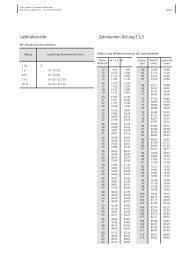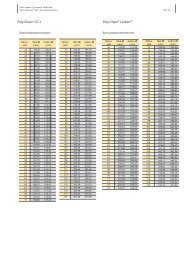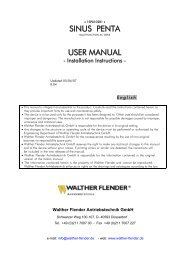PolyChain® GT Timing Belts - Walther Flender
PolyChain® GT Timing Belts - Walther Flender
PolyChain® GT Timing Belts - Walther Flender
You also want an ePaper? Increase the reach of your titles
YUMPU automatically turns print PDFs into web optimized ePapers that Google loves.
<strong>Walther</strong> <strong>Flender</strong> Gruppe<br />
PolyChain ® <strong>GT</strong> <strong>Timing</strong> <strong>Belts</strong> PAGE 15<br />
Belt tension<br />
The Poly Chain® timing belt needs a certain tension during operation<br />
to maintain reliable engagement of the teeth also under<br />
intermittent loads and temporary overloads. Unnecessarily high<br />
initial tension reduces the service life of the drive system, increases<br />
wear on the bearings and the teeth, and also increases the noise<br />
level. Insufficient tension can prevent the belt teeth from meshing<br />
properly in the pulley teeth, which can even cause the belt to<br />
skip in case of an overload. Depending on the application and the<br />
particular dynamic peak loads, the belt tension can deviate from<br />
the calculated initial tension, so that the calculation provided here<br />
should be used only as a recommendation for standard applications.<br />
This applies especially to drive systems with extreme impact<br />
and pulse loads; in this case, please contact us.<br />
Calculation of the static initial load<br />
F St = K · P + m · v 2<br />
v<br />
F St [N] = Static initial tension<br />
P [kW] = Installed motor power output<br />
v [m/s] = Belt speed<br />
m = Factor for weight per metre, see table<br />
K = Constant for compensating for<br />
impact loads<br />
K = 600 max. initial tension for compensating for pulse loads<br />
Pitch Belt width (mm) m Y<br />
8 mm 12 0.057 80<br />
21 0.098 140<br />
36 0.167 240<br />
62 0.290 413<br />
14 mm 20 0.158 245<br />
37 0.291 454<br />
68 0.536 834<br />
90 0.711 1103<br />
125 0.986 1530<br />
Table: Calculation factors for belt tension<br />
If the transmission capacity is significantly higher than the calculated<br />
capacity of the belt, the calculations can result in incorrect<br />
belt tensions. In this case, please use the minimum initial tensions<br />
specified in the following table:<br />
Pitch Belt width (mm)<br />
8 mm<br />
14 mm<br />
Min. F st<br />
Values (N)<br />
12 125<br />
21 220<br />
36 375<br />
62 645<br />
20 530<br />
37 980<br />
68 1800<br />
90 2380<br />
125 3310<br />
Table: Minimum initial tension of <strong>PolyChain®</strong> timing belts<br />
Checking the belt tension<br />
Two methods can be used for checking the belt tension:<br />
1. Frequency measurement and 2. Test load method<br />
1. Frequency measurement<br />
A precise method for pre-setting the correct belt tension is to<br />
measure the frequency with the WF Tension Meter (Figure 1) or<br />
the Gates-Sonic Tension Meter (Figure 2). With a sensing head<br />
that is held above the installed belt it is possible to measure the<br />
frequency at the pre-tensioned belt in order to achieve the optimum<br />
belt tension.<br />
The calculated oscillation frequency f [Hz] depends on the freely<br />
oscillating span length L [m], the static initial tension load FSt [N]<br />
and the weight per meter m [kg/m] of the belt and corresponds<br />
to the relationship<br />
f = 1 · √ F St<br />
2 · L m<br />
For a detailed description of the instruments and detailed calculation<br />
documentation, please contact our application engineers.<br />
2. Test load method<br />
Calculation of deflection<br />
S = √A2 – [ dwG – d 2<br />
wk ]<br />
2<br />
S : Span length for test force measurement (mm)<br />
d : Deflection (mm)<br />
dwk : Pitch diameter of the small pulley (mm)<br />
dwG : Pitch diameter of the large pulley (mm)<br />
FP : Test force (N)<br />
A : Centre distance of axes (mm); separate tables are available<br />
for the calculation and will be provided on request.<br />
If the span tension is set correctly, the deflection is<br />
d ~ 1 / 100 · S<br />
Calculation of test force<br />
Figure 1:<br />
WF Tension Meter<br />
S<br />
d<br />
FP<br />
Figure 2:<br />
Gates Sonic Tension<br />
Meter 507C<br />
F St + S · Y F P : Test force (N)<br />
F P = l w F St : Static initial tension<br />
25 l w : Pitch length (mm)<br />
Y : Constant (see table)<br />
Adjusting the initial tension<br />
For the calculated test force, the deflection should be ca. 1/100 of<br />
the span length [mm] of the test force measurement. It may be<br />
necessary to correct the belt tension.

















